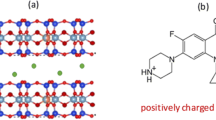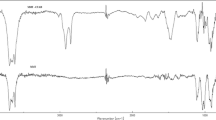Abstract
Gelatin, because of its biodegradability and ecofriendly nature, has been the best choice for controlled release applications. Montmorillonite (MMT) clay shows a very important role in controlling drug delivery. Hence, an attempt was made in this work to prepare gelatin–MMT nanoparticles by desolvation method using acetone as precipitating agent, glutaraldehyde (GA) as crosslinking agent, and water as reaction media for controlled delivery of isoniazid, a drug for tuberculosis. Characterization of the MMT and isoniazid-loaded gelatin–MMT nanoparticles was carried out using Fourier transform infrared spectroscopy, X-ray diffraction study, scanning electron microscopy study, and transmission electron microscopy study. The effect of MMT on gelatin nanoparticles was evaluated in terms of water uptake studies, and subsequently to the release of isoniazid drug in buffer solution at pH 1.2 (gastric pH) and pH 7.4 (intestinal pH). Swelling experiment indicated that the gelatin nanoparticles were very sensitive to the pH environment. The release profile of drug was studied by a UV–Visible spectrophotometer. Cytotoxicity study revealed that MMT-containing nanoparticles showed less cytotoxicity than MMT-free nanoparticles.









Similar content being viewed by others
References
Uhrich KE, Cannizzaro SM, Langer RS, Shakesheff KM (1999) Polymeric systems for controlled drug release. Chem Rev 99:3181–3198
Riva R, Ragelle H, Rieux AD, Duhem N, Jerome C, Preat V (2011) Chitosan and chitosan derivatives in drug delivery and tissue engineering. Adv Polymer Sci 244:19–44
Lee EJ, Khan SA, Park JK, Lim KH (2012) Studies on the characteristics of drug-loaded gelatin nanoparticles prepared by nanoprecipitation. Bioprocess Biosyst Eng 35:297–307
Kevadiya BD, Rajkumar S, Bajaj HC, Chettiar SS, Gosai K, Brahmbhatt H, Bhatt AS, Barvaliya YK, Dave GS, Kothari RK (2014) Biodegradable gelatin-ciprofloxacin-montmorillonite composite hydrogels for controlled drug release and wound dressing application. Colloid Surf B 122:175–183
Jahanshahi M, Babaei Z (2008) Protein nanoparticle: a unique system as drug delivery vehicles. Afr J Biotechnol 7:4926–4934
Bajpai AK, Choubey J (2006) Design of gelatin nanoparticles as swelling controlled delivery system for chloroquine phosphate. J Mater Sci Mater Med 17:345–358
Kaintura R, Sharma P, Singh S, Rawat K, Solanki PR (2015) Gelatin nanoparticles as a drug delivery system for proteins. J Nanomed Res 2:00018. doi:10.15406/jnmr.2015.02.00018
Foox M, Zilberman M (2015) Drug delivery from gelatin based systems. Expert Opin Drug Deliv 5:1–17
Azimi B, Nourpanah P, Rabiee M, Arbab S (2014) Producing gelatin nanoparticles as delivery system for bovine serum albumin. Iran Biomed J 18:34–40
Saraogi GK, Sharma B, Joshi B, Gupta P, Gupta UD, Jain NK, Agrawal GP (2011) Mannosylated gelatin nanoparticles bearing isoniazid for effective management of tuberculosis. J Drug Target 19:219–227
Das PR, Nanda RM, Behara A, Nayak PL (2011) Gelatin blended with nanoparticle cloisite30B (MMT) for control drug delivery of anticancer drug paclitaxel. Int Res J Biochem Bioinform 1:35–42
Suresh R, Borkar SN, Sawant VA, Shende VS, Dimble SK (2010) Nanoclay drug delivery system. Int J Pharm Sci Nanotechnol 3:901–905
Zheng J, Shan J, Fan Z, Yao K (2011) Preparation and properties of gelatin-chitosan/montmorillonite drug-loaded microspheres. J Wuhan Univ Technol-Mater Sci Ed 26:628–633
Joshi GV, Kevadiya BD, Patel HA, Bajaj HC, Jasra RV (2009) Montmorillonite as a drug delivery system: intercalation and in vitro release of timolol maleate. Int J Pharm 374:53–57
Haywood A, Mangan M, Grant G, Glass BD (2005) Extemporaneous isoniazid mixture: stability implications. J Pharm Pract Res 35:181–182
Ramachandran R, Shanmughavel P (2010) Preparation and characterization of biopolymeric nanoparticles used in drug delivery. Indian J Biochem Biophys 47:56–59
Xu H, Shen L, Xu L, Yang Y (2015) Controlled delivery of hollow corn protein nanoparticles via non-toxic crosslinking: in vivo and drug loading study. Biomed Microdevices 17:8. doi:10.1007/s10544-014-9926-5
Zheng JP, Luan L, Wang HY, Xi LF, Yao KD (2007) Study on ibuprofen/montmorillonite intercalation composites as drug release system. Appl Clay Sci 36:297–301
Nayak UY, Gopal S, Mutalik S, Ranjith AK, Reddy MS, Gupta P, Udupa N (2009) Glutaraldehyde cross-linked chitosan microspheres for controlled delivery of zidovudine. J Microencapsul 26:214–222
Iman M, Bania KK, Maji TK (2013) Green jute-based cross-linked soy flour nanocomposites reinforced with cellulose whiskers and nanoclay. Ind Eng Chem Res 52:6969–6983
Whipple EB, Ruta M (1974) Structure of aqueous glutaraldehyde. J Org Chem 39:1666–1668
Devi N, Maji TK (2010) Microencapsulation of isoniazid in genipin-crosslinked gelatin-A–k-carrageenan polyelectrolyte complex. Drug Dev Ind Pharm 36:56–63
Selvaraj S, Saravanakumar N, Karthikeyan J, Deborah Evangeline D, Lathamary Rajendran NN (2010) Acyclovir loaded chitosan nanoparticles for ocular delivery. Der Pharmacia Lettre 2:420–431
Devi N, Maji TK (2009) Preparation and evaluation of gelatin/sodium carboxymethyl cellulose polyelectrolyte complex microparticles for controlled delivery of isoniazid. AAPS PharmSciTech 10:1412–1419
Cassano R, Trombino S, Ferrarelli T, Mauro MV, Giraldi C, Manconi M, Fadda AM, Picci N (2012) Respirable rifampicin-based microspheres containing isoniazid for tuberculosis treatment. J Biomed Mater Res A 100:536–542
Ahuja A, Khar RK, Ali J (1997) Mucoadhesive drug delivery systems. Drug Dev Ind Pharm 23:489–515
Park K, Robinson JR (1984) Bioadhesive polymers as platforms for oral controlled drug delivery: method to study bioadhesion. Int J Pharm 19:107–127
Hussain A, Saikia V, Ramteke A (2012) Nitric oxide and modulatory effects of the root extracts of phlogacanthus tubiflorus against oxidative stress induced by hydrogen peroxide. Free Radic Antioxd 2:8–11
Gomez-Lechon MJ, Iborra FJ, Azorin I, Guerri C, Renau-Piqueras J (1992) Cryopreservation of rat astrocytes from primary cultures. Methods Cell Sci 14:73–77
Denizot F, Lang R (1986) Rapid colorimetric assay for cell growth and survival. Modifications to the tetrazolium dye procedure giving improved sensitivity and reliability. J Immunol Methods 89:271–277
Daly LE, Bourke GJ (1985) Interpretation and uses of medical statistics, 3rd edn. Blackwell Science, Oxford
Hua S, Yang H, Wang A (2010) A pH-sensitive nanocomposite microsphere based on chitosan and montmorillonite with in vitro reduction of the burst release effect. Drug Dev Ind Pharm 36:1106–1114
Sarmento B, Ribeiro A, Veiga F, Sampaio P, Neufeld R, Ferreira D (2007) Alginate/chitosan nanoparticles are effective for oral insulin delivery. Pharm Res 24:2198–2206
Fukuoka E, Makita M, Yamamura S (1993) Pattern fitting procedure for the characterization of crystals and/or crystallites in tablets. Chem Pharm Bull 41:2166–2171
Bahari A, Asgharzadeh M, Najafikhah M (2011) Sodium nanoparticle effects on montmorillinite structure. Afr J Appl Chem 5:429–435
Lu WH, Zhao GJ, Xue ZH (2006) Preparation and characterization of wood/montmorillonite nanocomposites. For Stud China 8:35–40
Ping LI, Jun-ping Z, Kang-de Y (2001) Study on intercalation mechanism of gelatin/MMT nanocomposite. Trans Tianjin Univ 7:294–296
Angadi SC, Manjeshwar LS, Aminabhavi TM (2010) Interpenetrating polymer network blend microspheres of chitosan and hydroxyethyl cellulose for controlled release of isoniazid. Int J Biol Macromol 47:171–179
Devi N, Maji TK (2011) Study of complex coacervation of gelatin A with sodium carboxymethyl cellulose: microencapsulation of neem (azadirachta indica A. juss.) seed oil (NSO). Int J Polymer Mater 60:1091–1105
Su X, Zhang G, Xu K, Wang J, Song C, Wang P (2008) The effect of MMT/modified MMT on the structure and performance of the superabsorbent composite. Polymer Bull 60:69–78
Deka BK, Maji TK (2010) Effect of coupling agent and nanoclay on properties of HDPE, LDPE, PP, PVC blend and Phargmites karka nanocomposite. Compos Sci Technol 70:1755–1761
Seema, Datta M (2013) MMT-PLGA nanocomposites as an oral and controlled release carrier for 5-fluorouracil: a novel approach. Int J Pharm Pharm Sci 5:332–341
Wang X, Du Y, Luo J (2008) Biopolymer/montmorillonite nanocomposite: preparation, drug-controlled release property and cytotoxicity. Nanotechnology 19:1–7
Iman M, Maji TK (2012) Effect of crosslinker and nanoclay on starch and jute fabric based green nanocomposites. Carbohydr Polym 89:290–297
Dong Y, Feng S (2005) Poly (d, l-lactide-co-glycolide)/montmorillonite nanoparticles for oral delivery of anticancer drugs. Biomaterials 26:6068–6076
Acknowledgements
The author M. Sarmah is highly acknowledged to University Grant Commission (UGC) for financial support as a form of institutional fellowship.
Author information
Authors and Affiliations
Corresponding author
Rights and permissions
About this article
Cite this article
Sarmah, M., Banik, N., Hussain, A. et al. Study on crosslinked gelatin–montmorillonite nanoparticles for controlled drug delivery applications. J Mater Sci 50, 7303–7313 (2015). https://doi.org/10.1007/s10853-015-9287-3
Received:
Accepted:
Published:
Issue Date:
DOI: https://doi.org/10.1007/s10853-015-9287-3




